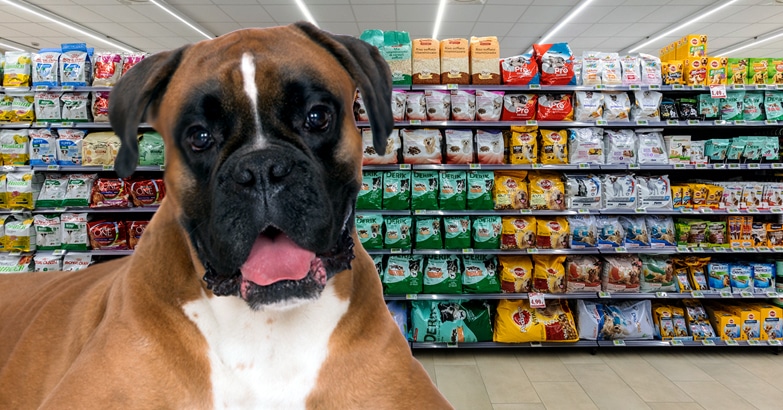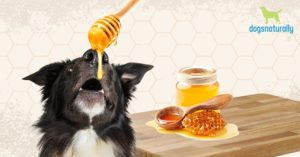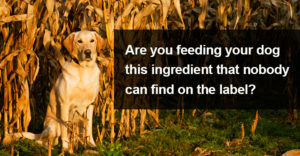Whether through carelessness or deceit, what’s on the pet food labels may not be what’s in the food.
Way back in the last century (1999), I worked full-time as an animal rights activist. We were trying to find out whether rumors were true that there were dogs – euthanized at shelters – in dog food. The laboratories I consulted said that heat processing destroyed DNA. There was no way to test for it.
As it turned out, a method existed, but it was new, and not in wide use. In 1993, the development of the PCR (polymerase chain reaction) won the Nobel Prize. PCR is a fast, accurate way to identify specific genetic material in a sample.
PCR became a powerful tool for detecting DNA in processed pet foods. Researchers began comparing the known DNA of various species to a sample from a bag or can of pet food. Now they could determine what species actually were – and were not – present in the product.
Let’s Test Some Pet Foods!
Researchers in Taiwan were among the first to publish their findings using this new technology on pet food. They bought several products, each claiming only one protein (1). Cattle, pig, goat and chicken DNA were found in all of them.
Pet foods can go awry by either containing proteins that are not listed on the label, or not containing proteins that are claimed on the label. The first situation is common; but the second is unusual. Quite a few studies on pet food have been published using PCR (and other methods of detection), with very disturbing results.
Here are results from testing of American-made products:
- A 2011 study found three out of four venison dry dog foods tested positive for soy and one for beef. Neither soy nor beef appeared on the labels (2).
- In 2014, research found that three of four OTC foods claiming “no soy” on the label did in fact contain soy. Four of seven veterinary diets intended for diet elimination trials contained soy protein (3).
- Of 52 pet foods and treats tested for the DNA of various animal species, almost 40% were mislabeled. A canned dog food that claimed to contain “deboned beef and beef broth” contained no beef at all, only pork. Chicken and pork were the most common unlisted species. Six foods did not list chicken on the label, but five of them contained chicken anyway. A popular dog treat supposedly made with bacon and beef contained only chicken—no beef, and no bacon (4). Out of all 52 samples, 51 contained chicken, regardless of the label.
- In 2016, researchers were comparing different detection methods. They used foods from several countries, including the US. The findings were startling. “Significant disparities were evident between the labelled contents and the detected content of animal by-products” (5).
- Of fourteen vegetarian and vegan diets tested, there was mammal DNA in half of them (6).
- A 2018 analysis found that half of the foods they tested were mislabeled. Unexpected added ingredients were more frequently detected than those missing from the label (7).
- A study in 2018 found that more than half of tested foods were mislabeled. Most contained unlisted animal ingredients. But some were missing ingredients that were listed on the label (8).
- A study done in Italy that included brands imported from the US found that 13 out of 14 brands included at least one mislabeled product. Dry foods were more likely than wet foods to contain unlabeled species (9).
- Twenty-one dog foods with “novel” or “limited” ingredients were analyzed. All of them contained unlabeled species (cow, pig, goat, and bison) (10).
- A 2021 study looked at new ways to test for mercury in pet foods. Along the way, they also analyzed the DNA in a few samples. One food listed beef, wild boar, goat, and lamb; but the sample contained chicken, turkey, and fish – no beef, boar, goat or lamb. Another sample claimed only tuna and salmon, but contained chicken, sheep, and turkey. Plant ingredients fared no better. A food proclaiming “no soy” contained – you guessed it! – soy. A food listing field peas and chickpeas contained neither. But it did contain flax, oats, and rice (11).
What PCR And WGS Reveal
New technology has taken the issue to new heights. Whole-genome sequencing (WGS) can determine dozens of species of plant or animal in a food product. In this brave new world, pet food fares even worse than before.
- PCR can detect DNA from known species. That is, the pet food could be compared against a set of DNA samples from chickens or cows because we already had DNA markers for those animals.
- WGS sequences all the DNA in the pet food itself. This can then be matched with known sequences of a much broader variety of species.
In a 2023 study, the researchers had to make many adjustments. WGS had not been used on such a complex product before. Earlier work used purified combinations of just a few ingredients. The researchers’ ingredient “library” was incomplete. Artificial samples were used in some cases. They found that WGS could not quantify the amount of each ingredient as they hoped. The raw sample of tofu used for the soy genome was contaminated with wheat, presumably during production. Raw rice contained traces of DNA from cattle, chicken, deer, salmon, and sheep, acquired at some point prior to purchase. So, while this first study is far from definitive, it shows that the problems with commercial pet food are serious and widespread. (9)
WGS is a very promising technology. And with it, dog foods fail again. Six tested dog foods contained chicken, although two specifically claimed not to. Wheat was also found in all samples, even though five of them were declared gluten-free. And most troubling of all, two samples were positive for dog DNA. Obviously, there should not be dogs in dog food! And so we’ve come full circle, back to the rumors that started it all.
At the very least, pet food suppliers and manufacturers are unconscionably careless in producing the food that the vast majority of dogs eat.
Pet Food Problems Are Global
It’s tempting to disparage American pet food makers. Recalls due to manufacturer and supplier errors are common. Our pets get sick, and sometimes they die. Inadequate thiamine and excessive vitamin D continue to cause many recalls. One vitamin D recall is ongoing and expanding even as I write this!
Taurine deficiency has also made a few headlines. It causes heart disease in certain breeds of dogs. (Recent claims by FDA about grain-free diets were wrong; there is no connection.) Lack of taurine also killed tens of thousands of cats from the same heart condition in the 1980s. All the foods involved claimed to be “complete and balanced,” according to the standards at the time. (New standards were published in 2007, but the studies they’re based on are more than 20 years old.)
The sad fact is that studies done elsewhere have found similar results. Europe, Thailand, and Brazil boast many pet food factories, and recalls happen there, too (we just don’t hear about them). Of course, the big US companies also ship all over the world. In one report, a veterinary diet for cats claimed chicken and chicken liver on the label, but there was zero chicken in the product. The US manufacturer says its exports are identical to the food it sells in the US. (12)
So, dry and canned commercial foods have problems. No surprise there! But what about raw? They’re more careful, right?
Only one study has looked at this issue in commercial raw diets. More than 60% of tested foods contained unlabeled species. Lamb was the most common unlabeled meat in raw dog foods (13).
The Pet Food Industry And Its Regulators
So, what was the response from AAFCO? None of the committee members had anything to say, but audience members did. An FDA bigwig opined that the problem was the suppliers. He said they must be mixing up ingredients or labels or something. This answer seemed satisfactory to most folks.
As a long-time advisor to AAFCO on behalf of animal welfare groups, I requested time to make a presentation at their 2015 annual meeting. There, I explained the research (only 5 studies at that time) showing that unlabeled proteins may be in the food. That’s a serious problem for many food allergic pets. They can be so itchy that they will scratch themselves raw.
Dogs With Allergies
Diagnosing allergies is not easy. Blood, hair, and skin tests are notoriously inaccurate. A strict elimination diet is the best way to test for food allergy. The diet should contain a different protein and carbohydrate than the pet’s usual food. If your dog has been eating a food with chicken and corn, you could select one with lamb and rice, or beef and barley. Many companies make diets with “novel” or “hypoallergenic” or “limited” or “hydrolyzed” ingredients. Their labels, websites, and marketing materials imply that their food would be helpful for allergic pets.
Yet DNA analysis proves that most of those foods contain unlisted proteins. Remember that analysis of 52 foods? Five of the six foods without chicken on the label did contain chicken. None of them will help a chicken-allergic dog. The dog keeps scratching, but neither the veterinarian nor their client knows why. A positive test due to an unlabeled protein could eliminate a diet that might otherwise be ideal (13).
Interestingly, the renderers stayed silent. Rendering is a very secretive industry. Dry pet foods rely heavily on rendered ingredients (meat and bone meal, poultry meal, lamb meal, etc.). Independent renderers accept raw materials from any source. They know how and why so much contamination occurs. Insiders say that, while it is easy to separate streams of materials right from the beginning of the process, renderers simply don’t bother. The philosophy appears to be: “grind it up, spit it out, and slap any old label on it.”
I suggested that the meat industry might want to “clean up its act.” The audience booed! They didn’t want to hear it. They didn’t want to discuss it. But mostly they didn’t want to do anything about it. FDA, state officials, manufacturers and suppliers have yet to take any action. Further studies show the problem is only getting worse.
I’ve worked with these people – regulators, manufacturers, suppliers – for more than twenty years. We generally have very congenial working relationships. But apparently I poked a very grumpy bear with my remarks!
RELATED: Read about marketing terms in pet foods …
More Excuses – From Nutrition Vets
I’m also a member of the American Academy of Veterinary Nutrition, which has an email bulletin board. I posted about this issue and asked, “What’s going on here?” I got very few responses, but one really surprised me. This expert blamed the problem on “cross-contamination.”
For example, she said, in a warehouse there could be a big pile of chicken meal next to a big pile of pork meal. Air currents could blow a little chicken into the pork, or vice versa. PCR is such a very sensitive test. PCR could be detecting the tiniest morsel that drifted from one pile to another! In fact, there is a lower limit of detection for PCR, and it is extremely unlikely that a few flakes of pork meal drifting to the pile of chicken meal would meet that threshold.
Another suggestion made slightly more sense. The cookers, extruders, dryers, and other machinery are supposed to be thoroughly cleaned between runs. That is, a batch of chicken dog food shouldn’t be run after a batch of salmon dog food without thorough cleaning in between. But if the cleaning isn’t done, or isn’t done well, those pesky PCR tests might pick up some residue left behind. The same goes for the trucks and railcars that deliver ingredients. Who wants to spend time and soap and water washing those out?
Makers of “veterinary” diets need extreme care because their formulations are precise. They are generally much better about ingredient purity and cleanliness than OTC foods. But remember, four out of seven veterinary diets still contained detectable levels of contamination.
Now, we needn’t discuss open piles of ingredients sitting in a huge warehouse. We don’t have to consider how those bulk ingredients would be scooped from that pile by a front-end loader. Nor must we imagine how easily the contents of the loader escape as it trundles around the factory.
The problems are quite obvious! But that’s how it is in the pet food industry. Don’t expect that any changes or improvements will be made. They won’t be.
Where Are The Missing Ingredients?
But it’s not just ingredients flying from pile to pile. It’s the flip side. How is it that a product could contain ZERO of what it claims on the label? Not even those who work for that particular company said a word. But I got told off by the list moderator for naming names – in a group where almost everyone works for a pet food company!
We know that suppliers sometimes cheat. The 2007 melamine recalls are a vivid memory for many of us; it was a scheme to make more money. Just a few years ago, one company paid for chicken meal but received inferior chicken by-product meal. Chicken meal and chicken by-product meal look very much alike. All meat meals do, in fact. They come from the renderer as dry brown, slightly greasy powders. Chicken and turkey yield a lighter brown powder compared to beef, but that’s really the only observable difference. They look, feel, and smell pretty much alike.
But wouldn’t you think that a big, multi-national company should have better quality controls than making bacon-flavored treats out of chicken? Is “Oops, our bad,” the best they can do?
How Picky Is PCR?
The labs I talked to in 1999 weren’t far wrong when they said DNA can’t be detected in cooked products. Heat does degrade DNA. Detecting species-specific DNA means that enough of it remained intact to find. Once found, the DNA has to go through purification before PCR is even run, and then there are filtering and other processes beyond that (11).
In general applications, PCR has a sensitivity (lowest limit of detection) between five and 20 mg/kg. To make it more accurate requires additional dilutions. That requires more materials, more time and, of course, more money.
Most of the pet food studies have therefore been qualitative, not quantitative. The DNA is there, or it isn’t.
Human medicine is where accuracy becomes crucial. The trigger for severe allergies is 10 parts per million (ppm) of the allergen. For us non-metric folks, that’s 0.00016 ounces (0.001 teaspoon) per pound. A test that can detect five to 20 ppm of an allergen doesn’t seem so unreasonable now, does it? (14) Reports of unlabeled species imply a real potential to cause allergic reactions.
Disrespectful And Dangerous!
The cavalier attitude of the pet food industry is just plain disrespectful to all the people who buy their products. But it goes further than just potential allergens. There are many ethical and religious prohibitions against certain animal products, like pork, seafood, or beef. Many families keep a kosher, halal, or vegan home. How would they feel to learn that pork is a common contaminant of dog food, or that there are animal products in their vegan pet food? The pet food industry clearly does not care.
Another potential problem deserves a mention. Young children in the crawling to toddling stage tend to put things in their mouths. What if a child has a severe allergy to a pet food ingredient? Or worse, to a contaminant? One little girl who commonly ate kibbles from the cat’s bowl developed a severe – and ultimately fatal – reaction to penicillin. When the cat food was tested, it contained 600 times the maximum allowable level for human food. But livestock condemned for human consumption due to excessive drug residues can go straight into pet food.
How Is This Okay?
It’s not. Mislabeling a product is adulteration and/or misbranding. Adulteration means there’s something there that shouldn’t be, like chunks of plastic, rodent feces, excessive pesticide residues, or antibiotics. Misbranding violates the Food, Drug, and Cosmetic Act, enacted in 1938 and amended many times since. The Act applies to both human and animal food. Mislabeling also violates other federal and state laws. The label on the package must accurately reflect what is in the package.
Such carelessness also violates “good manufacturing practices” under federal law (CFR 21). Title 21 is the basis for many state laws as well as the AAFCO model regulations. The FDA Compliance Guidelines for this section require preventive controls for known hazards.
Now, an itchy dog may not strike a supplier of pet food ingredients as a hazard. But it’s estimated that up to 25% of all allergic skin diseases in dogs are due to food allergy. When I was in vet school, that number was only about 10%. The uncaring attitude of the industry no doubt has played a role in the increase of food allergies.
The questionable cleanliness of equipment may also violate HARCP (Hazard Analysis and Risk-based Preventive Controls). It’s the current basis for the management of food safety. HARCP replaced the old HACCP (Hazard Analysis and Critical Control Points), which was more strict. It covers everything from raw materials to finished products. But HARCP is simply “the fox guarding the henhouse.” HARCP leaves producers to create their own safety protocol – then use it to govern themselves.
RELATED: Learn about new pet food labels starting in 2024 ...
What Does This Mean For Your Dog?
Food allergies are of great concern in humans, affecting up to 10% of the population. For some substances, even 10 parts per million (ppm, or 10 mg/kg) is enough to cause a fatal allergic reaction. But even less could still cause major problems for your dog, who eats the same food every day. One veterinary researcher commented that “even small amounts of allergens may lead to a cumulative reaction.”
A review looked at all the evidence up till 2018. The conclusion was harsh. Up to 80% of dry, canned, limited-antigen, raw, and plant-based diets may contain unlabeled species (8). Those are pretty terrible odds, but the reality is likely even worse! The whole-genome sequencing study is very disheartening, suggesting that contamination is common, perhaps universal.
According to all these trials, novel-ingredient or single-protein diets likely contain unlisted proteins. Even if one bag of one food works to begin with, the next bag may be more contaminated. Additionally, many allergic dogs go on to develop new allergies over time. When the label fails to accurately state what is in the food, you and your dog will be the biggest losers.
The issue of pet food quality and purity impacts the entire industry. It’s time for us pet owners to get serious about our dogs’ well-being, because the pet food makers aren’t interested. I like to think that there are small, perhaps local companies who are doing a good job and have our pets’ best interests at heart. But to compete at a national level requires compromises – big ones, it seems.
Homemade Is Safer!
The only reliable solution for a safe, healthy diet – particularly an elimination diet – is homemade dog food. If you haven’t made dog food at home before, it can seem daunting. But once you get the hang of it, it goes quite smoothly. (Learn how to make homemade dog food.)
You make the food from ingredients you buy fresh at the store. That’s the only way can you know for sure what in the food. You’d need to apply the same high standards to any supplements. But in most cases, you can skip supplements for at least a few weeks to make the food as pure as can be.
A true allergy elimination protocol lasts for eight to twelve weeks, but you’ll be a pro by then. It’ll be great to watch your dog’s symptoms disappear.
But the benefits of a balanced and lovingly prepared home-made diet are not just for food-allergic dogs. When you transition to a homemade diet, your dog will be happier, less anxious, and more energetic – in fact he’ll be back to the normal loving dog he was as a puppy!
References
- Wang HC, Lee SH, Chang TJ, Wong ML. Examination of meat components in commercial dog and cat feed by using polymerase chain reaction-restriction fragment length polymorphisms (PCR-RFLPs) technique. Journal of Veterinary Medical Science. 2004 Jul;66(7):855-9.
- Raditic DM, Remillard RL, Tater KC. ELISA testing for common food antigens in four dry dog foods used in dietary elimination trials. Journal of Animal Physiology and Animal Nutrition (Berl). 2011 Feb;95(1):90-7.
- Willis-Mahn C, Remillard R, Tater K. ELISA testing for soy antigens in dry dog foods used in dietary elimination trials. J Am Anim Hosp Assoc. 2014 Nov-Dec;50(6):383-9.
- Okuma TA, Hellberg RS. Identification of meat species in pet foods using a real-time polymerase chain reaction (PCR) assay. Food Control. 2015; 50:9-17.
- Hsieh MK, Shih PY, Wei CF, Vickroy TW, Chou CC. Detection of undeclared animal by-products in commercial canine canned foods: Comparative analyses by ELISA and PCR-RFLP coupled with slab gel electrophoresis or capillary gel electrophoresis. Journal of the Science of Food Agriculture. 2016 Mar 30;96(5):1659-65
- Kanakubo K, Fascetti AJ & Larsen JA. Determination of mammalian deoxyribonucleic acid (DNA) in commercial vegetarian and vegan diets for dog and cats. Journal of Animal Physiology and Animal Nutrition (Berl). 2017; 10, 70–74.
- Olivry T, Mueller RS. Critically appraised topic on adverse food reactions of companion animals (5): discrepancies between ingredients and labeling in commercial pet foods. BMC Veterinary Research. 2018 Jan 22;14(1):24.
- Pagani E, Soto Del Rio MLD, Dalmasso A, et al. Cross-contamination in canine and feline dietetic limited-antigen wet diets. BMC Veterinary Research. 2018 Sep 12;14(1):283.
- Ricci R, Conficoni D, Morelli G, et al. Undeclared animal species in dry and wet novel and hydrolyzed protein diets for dogs and cats detected by microarray analysis. BMC Veterinary Research. 2018 Jun 27;14(1):209.
- Fossati LA, Larsen JA, Villaverde C, Fascetti AJ. Determination of mammalian DNA in commercial canine diets with uncommon and limited ingredients. Veterinary Medicine and Science. 2019 Feb;5(1):30-38.
- Dunham-Cheatham SM, Klingler KB, Estrada MV, et al. Using a next-generation sequencing approach to DNA metabarcoding for identification of adulteration and potential sources of mercury in commercial cat and dog foods. Science of the Total Environment. 2021; 778:146102
- Maine IR, Atterbury R, Chang KC. Investigation into the animal species contents in popular wet pet foods. Acta Veterinarian Scandanavia. 2015; 57:7-10.
- Cox A, Defalque VE, Udenberg TJ, et al. Detection of DNA from undeclared animal species in commercial canine and feline raw meat diets using qPCR. Canadian Veterinary Journal. 2020 Sep;61(9):977-984.
- Waiblinger HU, Geppert C, Bartsch D, et al. Collaborative trial validation of a new multiplex real-time PCR to sensitively detect allergenic nuts in foods. Journal of Consumer Protection and Food Safety. 2022; 17:265–277
- Platform 9 ¾. Zhu X, Alden EN, Edwards JS. Using Pet Food as the Subject to Investigate the Effectiveness of Whole-Genome Sequencing in the Authentication of Highly Processed Complex Food. ACS Food Sci. Technol.2023; 3:50−60.













